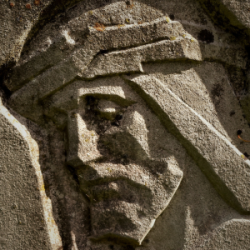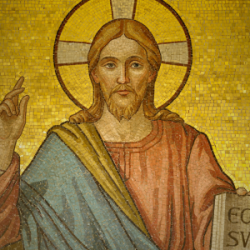Welcome readers! Please subscribe through the buttons at the right if you enjoy this post.

I want to emphasize that the saying of Jesus we are looking at here was not instruction to renounce one’s rights nor to become 1st Century door mats. Rather it was a tactical strategy for them to use in the midst of persecution, respond to their persecutors with love (see Loving Our Enemies), and actively furthering their work toward a safer, more compassionate society for all.
We find this Jesus saying in two passages:
Luke 6.29-30: “If anyone strikes you on the cheek, offer the other also; and from anyone who takes away your coat do not withhold even your shirt. Give to everyone who begs from you; and if anyone takes away your goods, do not ask for them again.”
Matthew 5.39-42: “But I say to you, Do not [reciprocate evil toward]* an evildoer. But if anyone strikes you on the right cheek, turn the other also; and if anyone wants to sue you and take your coat, give your cloak as well; and if anyone forces you to go one mile, go also the second mile. Give to everyone who begs from you, and do not refuse anyone who wants to borrow from you.”
There is much to unpack in this passage.
The list of peace activists from the last two centuries is long. This saying of Jesus has been influential, both directly and non-directly, in many of the nonviolent movements around the globe toward positive social change. Some of the most well known names in the last century were Gandhi in South Africa and India and Dr. Martin Luther King, Jr. here in America. There are lesser known names, as well, such as Dorothy Day and her nonviolent direct action on behalf of the poor in New York City, and many more.
In this passage, Jesus is teaching a bold and disruptive expression of nonviolence. It’s a nonviolence that seeks to confront one’s opponent and offer an opportunity for transformation. With each of these three examples, the oppressed person is shown potential ways of taking control of the situation, confronting their subjugator, and stripping them of the power to dehumanize.
First, let me say how deeply indebted I am to Walter Wink’s research on the cultural backdrop of the saying of Jesus we are considering this week. I’ll place a link to his work at the end of this section for further consideration. I consider his volume Jesus and Nonviolence: A Third Way to continue to be a revolutionary masterpiece.
Matthew’s version of this passage specifies that the cheek being struck is the “right” cheek. As most people are right-handed, the only natural way for a blow to land on the right cheek was if the striker used the back of their hand. This kind of blow in the culture of 1st Century Palestine was a show of insult from a superior to an inferior: one would not strike an equal in this humiliating way because doing so carried an fine of up to 100 times the normal amount. Four zuz was the fine for a blow to a social peer with a fist, but 400 zuz was the fine for backhanding one’s peer. To strike someone you viewed as socially inferior to yourself with a backhanded slap, was perfectly acceptable and no penalty was attached (see Mishnah Bava Kamma 8.6).
Try to picture the scene in your head. Since the left hand was only used for “unclean” tasks in that culture, people would not strike a person’s right cheek with that hand. At Qumran, even gesturing to another person while speaking using one’s left hand carried a penalty of exclusion from the community accompanied by ten days’ penance. (See The Dead Sea Scrolls, I QS 7, “Whoever has drawn out his left hand to gesticulate with it shall do penance for ten days.”) Any blows would have either been from a closed right fist with one’s right hand on someone’s left cheek, or a back-handed slap with one’s right hand on someone’s right cheek. A closed fisted blow from a person’s right hand on one’s left cheek acknowledged that the striker believed the one they were striking was their social equal. Someone claiming superiority over another would not want to strike them in this way. They would want to use an open-handed slap with the back of their hand on the other person’s right cheek as an attempt at humiliating the one they were striking. It was the equivalent of saying, “Get back in your place.” Also, keep in mind that any retaliatory blows from the person being struck by a “superior” would have only caused the violence to escalate.
But Jesus is not admonishing the oppressed in this scene to become a doormat or simply do nothing. Turning their left cheek would not be retaliation but defiance, a sign that the one being struck is refusing to be humiliated. The oppressor would now only have two options presented to them: a right-handed punch acknowledging the one being struck was their equal or a left-handed slap with the unclean hand. Both options would be unthinkable, and so they would lose their power in the situation. Something I would like to add to Wink’s research is that this would not be an act of self-denial on the part of the person being struck. The person being struck’s “self” is already being denied by their oppressor. This is self-affirmation in the face of an attempt by another to dehumanize them.
The next example in the passage involves a serious social problem in 1st Century Palestine: indebtedness. A little background first. The Torah allowed a creditor to take the himation (or outer garment) or chiton (inner garment) as security for loans from the wealthy to impoverished laborers (see Exodus 22:25-27 and Deuteronomy 24:10-13, 17). In this era, poor people had few clothes, and wealthy creditors had to return it daily so the owners could have their cloak to sleep in.
In that culture, debt was not the result of economic incompetence, but of an unjust economic system where the wealthy elite took advantage of rural peasant farmers and poor Jewish craftsmen. In our scenario, a poor laborer has defaulted on their loan and has come under the penalty of losing their next-to-last article of clothing.
Jesus’s saying teaches this laborer to “turn over” not just their next-to-last article of clothing but also their last one as well. This would leave them stark naked in the town square. Wink explains that in that society the shame of nakedness fell not on those whose nakedness was exposed, but on those who looked upon or were the cause of their nakedness. The honorable response would have been to respectfully help them (see Genesis 9.20-27). In a society where only the wealthy wore something similar to underwear, stripping off the undergarment along with the required outer garment would redirect the shame onto “the entire system by which the debtors are oppressed” as if to say, “Shame on you!” The teaching placed the poor laborer in control of the moment, exposing the system’s exploitation of Jesus’ fellow Jewish craftsmen and rural peasant farmers and shaming the powerful who take the last object of value from a sector of society which should be receiving their help. Here we have a 1st Century endorsement of public nudity as a valid form of radical, nonviolent protest, and the protest is designed by Jesus himself!
In our next example, Jesus teaches the oppressed to refuse to play by the rules of the game dictated by those controlling the society’s domination system.
Roman law allowed soldiers to command people in the occupied territories to carry their burdens for one mile—but only one mile. This limitation provided some protection for the people as one could otherwise find oneself having carried a soldier’s burden for an entire day only to end up now a day’s journey away from one’s home as the sun was going down.
Yet even this limitation was not good enough. We cannot be satisfied with merely accommodating the domination system; we must also refuse to cooperate with it. Remember King’s words from last week: “We cannot in all good conscience obey your unjust laws and abide by the unjust system, because non-cooperation with evil is as much a moral obligation as is cooperation with good.” So, Jesus says, when you reach the end of your first, forced mile and the soldier asks for their burden, don’t give it back! Place the soldier in the position of breaking their own system’s rules and perhaps being disciplined for it.
In each of these examples, the subjugated must make hard choices. They must decide whether they are willing to use possible further personal suffering to change society rather than resort to mere retaliation. Are they willing to accept the consequences for breaking unjust laws or policies? Are they willing to cease cooperating with the present order and its rules? And as we asked last week, do they hope for their oppressors’ transformation, or are they satisfied with the failing practice of tit-for-tat?
If you would like to further understand what may have been involved in this Jesus saying, again, consider reading the late Walter Wink’s book Jesus and Nonviolence: A Third Way. In this volume, Wink shows how Jesus’s teaching offered the oppressed ways to:
- Seize the moral initiative
- Find a creative alternative to violence
- Assert [their] own humanity and dignity as a person
- Meet force with ridicule or humor
- Break the cycle of humiliation
- Refuse to submit or to accept the inferior position
- Expose the injustice of the system
- Take control of the power dynamic
- Shame the oppressor into repentance
- Stand [their] ground
- Make the Powers make decisions for which they are not prepared
- Recognize [their] own power
- Force the oppressor to see [them] in a new light
- Deprive the oppressor of a situation where a show of force is effective (pp. 186-187)
The last section of this week’s saying reminds us, once again, to trust that God will send people to take care of us when we may have need in the future, enough to let go of our self-concerned hoarding, so we can be the people God may send to someone else who is in need, today. People taking care of people, remember, is what Jesus referred to as “the reign of God” or “The Kingdom.”
This call to trust had its own history with Jesus’s Jewish culture.
Hillel, one of the most important figures in Jewish history, lived somewhere between 110 BCE to 30CE. He was the first within Judaism to teach what today is referred to as the Golden Rule. Karen Armstrong in her excellent work The Great Transformation: The Beginning of Our Religious Traditions writes this about Hillel:
“Perhaps the greatest of the Pharisees was Rabbi Hillel (c. 80 BCE–30 CE), who migrated to Palestine from Babylonia. In his view, the essence of the Torah was not the letter of the law but its spirit, which he summed up in the Golden Rule. In a famous Talmudic story, it was said that one day a pagan approached Hillel and promised to convert to Judaism if the rabbi could teach him the entire Torah while he stood on one leg. Hillel replied simply: “What is hateful to yourself, do not to your fellow man. That is the whole of the Torah and the remainder is but commentary. Go learn it.” (Kindle Locations 7509-7515)
The most famous of the enactments attributed to Hillel is the Prozbul.
The Torah included a rule of protection for the poor against ever-increasing debt. At the end of every seventh (Sabbatical) year, all debts among the Jewish people were to be cancelled. By the 1st Century, even though it was forbidden to withhold a loan before a Sabbatical year (see Deuteronomy 15.9-11), some members of the wealthy elite were unwilling to lend to poor craftsman and rural peasant farmers who needed loans to survive.
In this context, Hillel created a loophole in the Jewish law. A declaration could be made in court before a loan was executed to the effect that the law requiring the release of debts upon the entrance of the Sabbatical year would not apply to the loan to be transacted. This declaration was called the Prozbul, and it benefitted both the rich and the poor in that the poor could more easily obtain the loans they so desperately needed whenever they needed them, and the rich would more freely lend with the assurance that the capital loaned was exempted from the law’s Sabbatical debt relief. (For more, read the Jewish Encyclopedia’s entry: Prozbul.)
Where Jesus’s teaching on the Golden Rule placed him squarely in the teaching stream of Hillel, Jesus parts ways with Hillel on the Prozbul. (I’ll talk about Jesus’s relationship with the School of Hillel and the School of Shammai two articles from now.)
Jesus taught that his followers should abandon their hoarded capital to aid those who need our help. A world under the reign of God looked like people trusting in God enough to believe that God would send others to take care of them tomorrow, so they could let go of what they were hoarding for future emergencies and take care of those whose emergencies were transpiring today.
Anxiety about the future can lead us down paths of accumulation, hoarding, greed, covetousness, jealousy, competition, and violence. It can cause us to look the other way and ignore those around us today who may be in need. But Jesus is calling us to let go of that anxiety about the future and all that it brings in its train. Let’s imagine, instead, a world where, rather than individualistically accumulating in order to take care of oneself in the future, everyone trusts that if we all begin taking care of one another today, we will have a future where others take care of us. In other words, if you will take care of someone else today, you will set in motion a world where, tomorrow, someone else will take care of you.
*In these cases, Jesus’ instructions are NOT commands of passive nonresistance. The phrase “resist not an evildoer” could be problematic if Jesus did not then demonstrate in these stories exactly what He meant. The underlying Greek word here is anthistemi. It indicates resistance by returning violence for violence, overcoming evil with evil, rather than overcoming evil with good.













